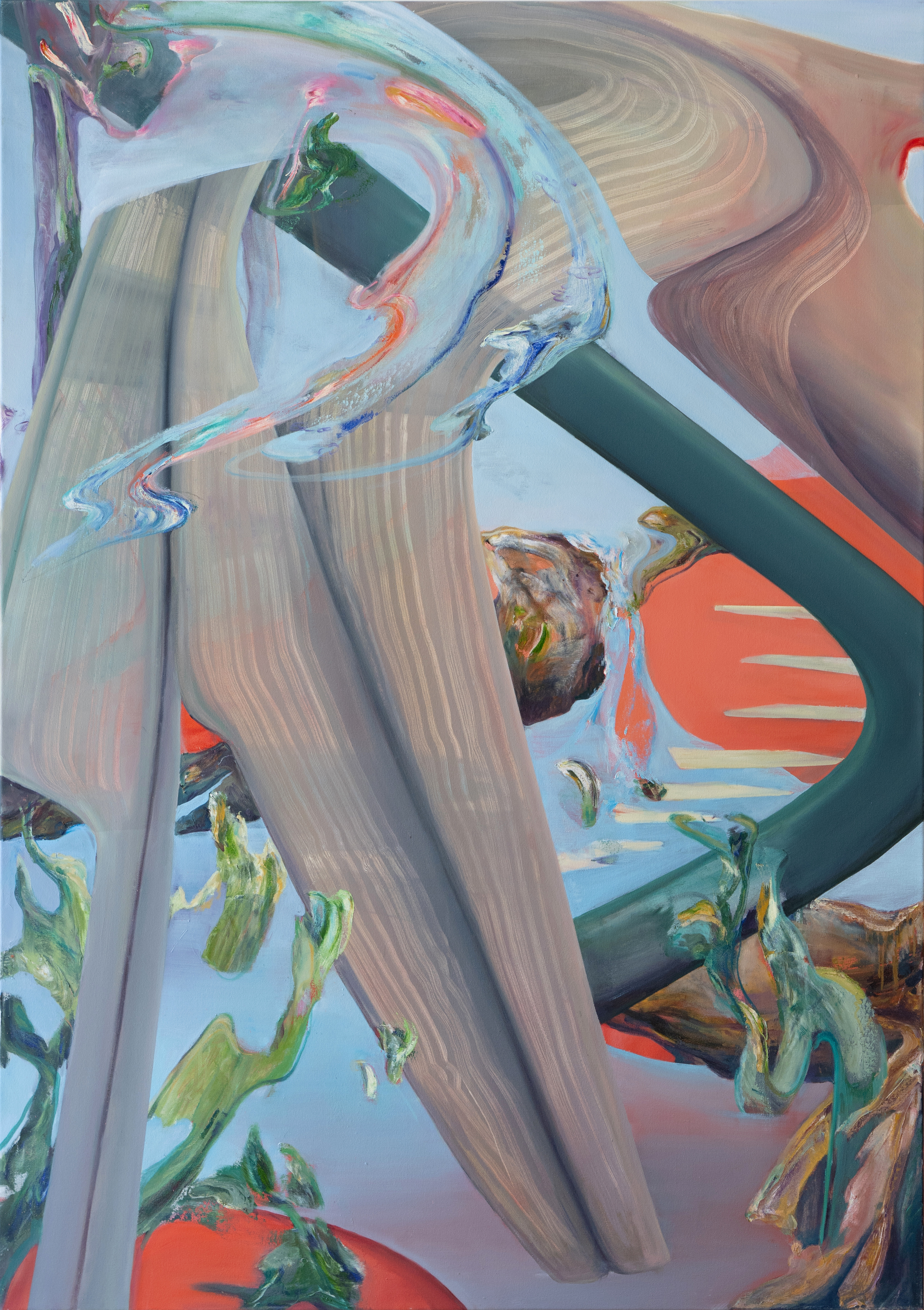Surfing
Impermanence
 Echoes of Impermanence, Clément Bedel – 18.12.2024
Echoes of Impermanence, Clément Bedel – 18.12.2024WUK Projectraum, Vienna 1090
The history of painting is, in many ways, a history of currents—of tides that flow beneath and above the visible register. These are the submerged and the surfacing movements, the minor undercurrents and the dominant overflows, whose interplay forms a layered cartography of image and gesture. In Echoes of Impermanence, Clément Bedel invites us into a terrain where painting becomes less a window than a wave, and where vision is less an act of seeing than of surfing.
To surf a painting is to let go of the linear. It is to enter a mode of embodied perception where movement precedes meaning, where the surface is not a skin but a sequence—a field of echoes, sediments, ruptures, and returns. Bedel’s new works do not present themselves as static objects but as temporal experiences. They unfold as if already in motion, already in decay, already remembering what has been overlaid, scraped, or forgotten.
The surfboard in this analogy is not just a vehicle but a method—a cognitive and perceptual apparatus that glides along a field of accumulated gestures. Here, the canvas operates as a Doppler surface, a resonance chamber where meaning is always slightly delayed, always refracted, doubled, or spilt. The distinction between the overcoat and the undercurrent collapses into a recursive play of surfacing and submerging. The painting ceases to be a finished form and instead becomes a temporal event—an impermanent inscription on the edge of perception.
What is crucial here is the contradiction at the core of painting itself: its claim to permanence, and its persistent state of impermanence. In Bedel’s practice, this contradiction is not resolved but enacted. Each canvas bears witness to a history of cancellations, reworkings, obliterations, and reappearances. These are paintings that remember. The overpainted becomes the undercurrent; the buried gesture is what gives rise to the visible form. What we encounter is not merely what is shown, but what resurfaces from prior refusals—ghosted traces, spectral lines, muffled voices of past attempts.
There is a quiet violence in this process: the violence of overwriting, of layering, of re-coating the gesture. But there is also care, and a refusal to let the act of painting settle into finality. In this sense, Bedel’s practice can be understood as a form of Surfism—a poetics of impermanence that aestheticizes the moment of slippage, spillage, and unfixing. It is not an art of resolution, but of movement; not of control, but of negotiation with the medium’s historical residue.
To surf, in this context, is not to play, but to persist. Not to master the wave, but to stay with its instability. Surfing becomes a metaphor for a cognitive discipline—an act of receptivity to the in-between, the not-yet-coherent, the half-seen. Bedel’s paintings perform this discipline by never allowing the image to settle. They fracture and reconstitute themselves before the viewer, demanding not only attention but attunement. The eye becomes an instrument of tracking, of feeling through and along with the painting’s own search for its form.
Images, in this series, break—but they break like waves, not like objects. They do not shatter; they crest and disperse, returning again as foam, shimmer, or after-image. This cyclical temporality dislodges painting from the authority of fixed meaning and situates it within a continuum of appearing and disappearing. The field of vision becomes a temporal medium, and light—a traditional emblem of painting’s truth—is treated less as illumination than as wavelength, rhythm, resonance.
We are reminded that to see is already to interpret, to frame, to misrecognize. The separation between the image and the world it references is undone. Bedel’s work refuses the distance necessary for rational contemplation, and instead draws us into the immediacy of affective perception. His abstraction is not about reduction or detachment, but about sedimentation—a layering of time, emotion, and thought. This is not abstraction as negation, but as complexity.
The painter’s gesture here is both intimate and impersonal. It emerges from a bodily engagement with the medium, yet it always gestures beyond itself—toward something unspeakable, something submerged in the very act of surfacing. It is an ontology of flux, not form. A motion that carries with it the memory of past velocities, the undertow of previously submerged lines, and the overcoat of what was never fully present.
In this way, Echoes of Impermanence contributes not just to the visual history of painting but to its philosophical horizon. It repositions painting as a site of ungrounding, where perception meets time in a liquid state—where the surface is not a boundary but a passage. The “sum-space” of Bedel’s canvases is a space of simultaneity, where overcurrents and undercurrents co-exist, overlap, and entangle. And it is in this entanglement that the painting becomes not a thing to be seen, but a phenomenon to be surfed.

Text by Darko Vukić
